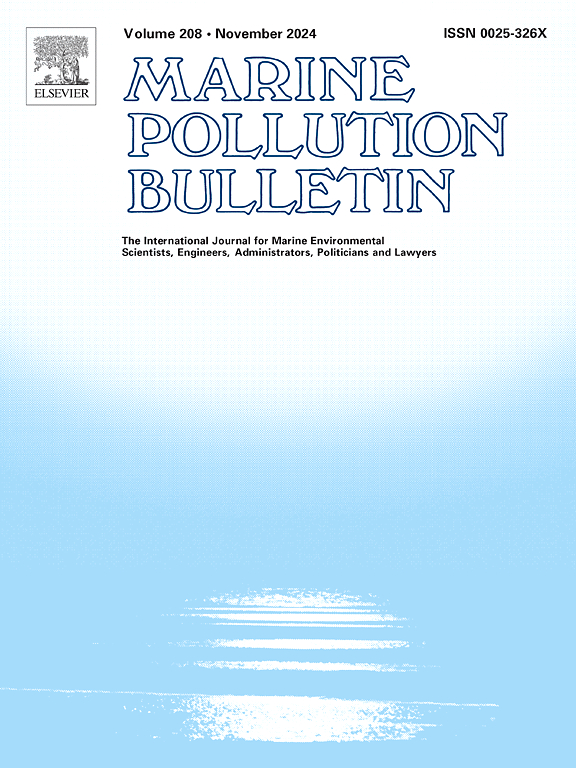Trace elements and POPs in baitfish from Madagascar: Implications for whale shark and human exposure
IF 5.3
3区 环境科学与生态学
Q1 ENVIRONMENTAL SCIENCES
引用次数: 0
Abstract
The rapid increase of human activities is threatening the ocean biodiversity, with marine vertebrates, particularly elasmobranchs, facing higher extinction risks. Among them, the whale shark (Rhincodon typus), an endangered migratory filter-feeding species, is threated by multiple anthropogenic pressures, including marine pollution. This study focuses on determining the presence and levels of legacy contaminants (PCBs, DDT) and trace elements (TEs) in baitfish, a primary prey species of whale sharks in Madagascar, and assessing the potential risks to whale sharks and humans through the consumption of contaminated baitfish (Sardinella gibbosa). Results indicate that while levels of DDT were below environmental safety thresholds, Hg levels in baitfish exceeded the acceptable limit, posing significant bioaccumulation risks to higher trophic level organisms, including whale sharks. Furthermore, comparisons with established maximum allowable limits for foodstuffs consumption revealed that Sardinella gibbosa may pose both non-carcinogenic and carcinogenic health risks to humans, particularly for pollutants like PCB, Cd, Ni, and Hg. This research highlights the importance of considering baitfish consumption as a significant pathway for pollutant uptake in whale sharks, suggesting that their exposure may be far higher than previously estimated through zooplankton alone. These findings underscore the critical need for continued monitoring of chemical pollution in coastal ecosystems, which are vital hotspot for global marine biodiversity, particularly in regions like Madagascar, where pollution from industrial, agricultural, and mining activities exacerbates the risk to both marine biodiversity and human health.

马达加斯加鱼饵中的微量元素和持久性有机污染物:对鲸鲨和人类暴露的影响
人类活动的快速增加正威胁着海洋生物多样性,海洋脊椎动物,特别是板鳃动物面临着更高的灭绝风险。其中,鲸鲨(Rhincodon typus)是一种濒临灭绝的迁徙滤食性物种,受到包括海洋污染在内的多种人为压力的威胁。本研究的重点是确定诱饵鱼(马达加斯加鲸鲨的主要猎物)中遗留污染物(多氯联苯、滴滴涕)和微量元素(TEs)的存在和水平,并评估食用受污染的诱饵鱼(沙丁鱼)对鲸鲨和人类的潜在风险。结果表明,虽然滴滴涕的含量低于环境安全阈值,但诱饵鱼中的汞含量超过了可接受的限度,对包括鲸鲨在内的高营养级生物构成了重大的生物积累风险。此外,通过与已确定的食品消费最大允许限量的比较发现,长尾沙丁鱼可能对人类造成非致癌性和致癌性健康风险,特别是对多氯联苯、Cd、Ni和Hg等污染物。本研究强调了将食用诱饵鱼作为鲸鲨摄取污染物的重要途径的重要性,表明它们的暴露量可能远远高于之前仅通过浮游动物估计的水平。这些研究结果强调,迫切需要继续监测沿海生态系统中的化学污染,这是全球海洋生物多样性的重要热点,特别是在马达加斯加等地区,工业、农业和采矿活动造成的污染加剧了对海洋生物多样性和人类健康的风险。
本文章由计算机程序翻译,如有差异,请以英文原文为准。
求助全文
约1分钟内获得全文
求助全文
来源期刊

Marine pollution bulletin
环境科学-海洋与淡水生物学
CiteScore
10.20
自引率
15.50%
发文量
1077
审稿时长
68 days
期刊介绍:
Marine Pollution Bulletin is concerned with the rational use of maritime and marine resources in estuaries, the seas and oceans, as well as with documenting marine pollution and introducing new forms of measurement and analysis. A wide range of topics are discussed as news, comment, reviews and research reports, not only on effluent disposal and pollution control, but also on the management, economic aspects and protection of the marine environment in general.
 求助内容:
求助内容: 应助结果提醒方式:
应助结果提醒方式:


